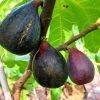Position
The Genoa Fig thrives in full or partial sunlight, i.e., five to six hours of sunlight daily. They can grow in sub-tropical regions and also in colder climates, cover young trees though in winter. Space at least 5m away from structures and other trees.
Size
A fast-growing, medium-sized deciduous tree. When mature, this tree reaches a height of between 3 and 4.5 m. Many gardeners prune them to be a little shorter. They have a slightly wider spread than most trees.
Soil Type
Black Genoa Figs thrive in well-draining, fertile, slightly sandy to loamy soil with a neutral pH, enriched with compost or well-rotted manure. Figs can adapt to various conditions, provided they are not waterlogged, to prevent root rot.
Watering
Generally, fig trees need about 2.5 to 4 cms of water a week. During the cooler months, the Black Genoa fig tree typically requires minimal watering, unless the soil has completely dried out. During the hot, dry season, water them once a week. If the leaves start turning yellow, this is a sign that they require more water.
Mulching
Apply organic mulch to your Fig tree throughout the year.
Use 2 to 5 cm of pine bark mulch to protect the roots from UV damage and drying out. It retains moisture and maintains an optimal pH. Do not let the mulch touch the plant stem, as it may cause infection or rot.
Fertilising
Apply our slow-release all-plant fertiliser. Apply 1 teaspoon every 4-5 months. The roots will absorb what they need.
Alternatively, apply a balanced fertiliser (such as 10-10-10) in early spring before new growth begins. Thereafter, fertilise annually in early spring.
Pruning
The best time to prune your fig tree is during winter when the tree is not actively growing. Cut off unwieldy branches or those that have become too long for your space.
Pests and Diseases
You may encounter fig tree borers, fig moths, fruit flies, scale insects, mealybugs, spider mites, caterpillars, wasps, and various beetles, which feed on leaves, bark, or fruit. Prevention by placing netting is an option; however, spraying regularly with Agricultural Neem Oil or Effective Microorganisms (EM Control ) can assist in either prevention or after the fact control. If you already have pests, wash the tree with a harsh hosing, and when dry, spray with Neem oil or EM Control.
Practice good garden hygiene (remove fallen fruit and leaves).
Watch for root rot (caused by overwatering) and fungal infections during wet periods.
Harvesting
Figs will ripen from December through to April. They are ready to pick when they become soft to the touch, their necks soften, and they start to droop.






